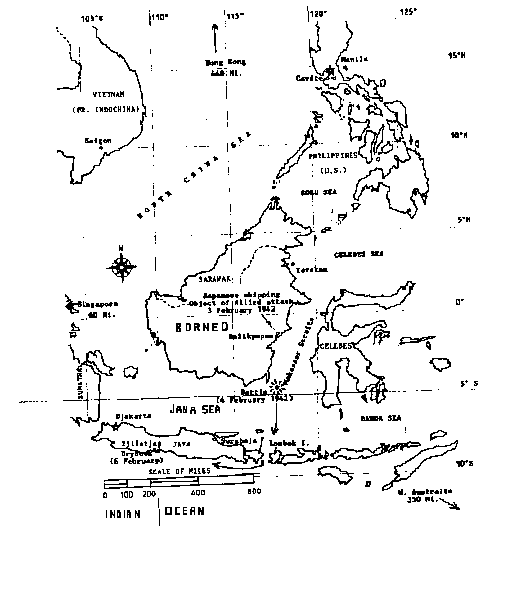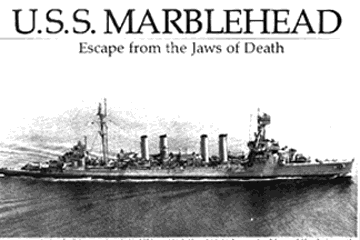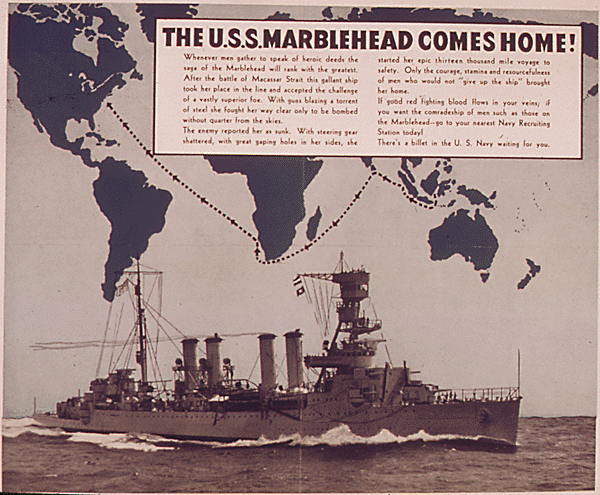|
Whenever daring deeds of the sea are recalled, the saga of
the U.S.S. Marblehead commands respect.
Mauled by Japanese bombs just after the U S. entry into World War ll, the ship was saved by her crew and -- after a 9,000-mile voyage to safety and a complete refit -- returned to the fight. At a time when many mightier warships were left rusting among the Pacific corals, the Marblehead was saved by courageous leadership, desperate
toil, and good fortune.
The Marblehead was a light cruiser. Launched in 1923, she was
built for speed -- 555 feet long, 55 feet in beam, and quadruple
screwed. At 35 knots, she was a stirring sight: the slender bow
threw up a dramatic wave, while above, bristling guns, spidery
tripod masts, and four smoking funnels presented a dashing profile.
She carried ten 6-inch guns, six poking from embrasures in the
superstructure, four in twin turrets fore and aft. Seven 3-inch
guns, eight machine-guns, and a full complement of torpedoes
completed her armament.
From 1938 on, the Marblehead was stationed in the Far East, a hotbed of confrontation with the Japanese. She helped protect American lives and property in this war-torn region. While the Japanese overran much of China and the Southwestern Pacific, the U.S. fielded only two cruisers (Houston and Marblehead), 13 over-age destroyers and minesweepers, and fleet auxiliaries, based at Cavite in the Philippines.
In November 1941, Admiral Hart ordered the Asiatic Fleet dispersed. Hence, none of the important U.S. units was caught in surprise air raids on Manila, synchronized with the Pearl Harbor attack. The Marblehead was at Tarakan, Dutch Borneo, when news
came of hostilities between the United States and Japan. Stripped
for action, she sailed at dawn on December 8, 1941. Later that
morning a flying fish sailed through one of her open portholes
-- an omen of disaster in Oriental superstition. Soon after,
the ship received a radio bulletin reporting itself sunk!
Her duties in those first desperate months reflected the Allies'
weakness in Asia. The Marblehead prepared for several missions which were aborted when the Japanese concentrated superior forces. Finally, in February 1942, the Allies gathered all their warships in the East Indies for a sortie against Japanese shipping. The force -- including the Marblehead , the heavy cruiser
Houston, two Dutch cruisers under Admiral Doorman, and seven
destroyers -- sailed for the Makassar Straits on February 3,
1942.
According to the formulas of speed and firepower then used to calculate odds on naval engagements, this task force matched the Japanese fleet opposing it. But -- as the record showed -- surface forces in the 1940s required air cover, and there the Japanese held a decisive edge. Save for a few small scouting planes, the Allies had no air support. When 40 Japanese bombers droned overhead en route to Surabaja, a port on the easternmost tip of Java, there were no American interceptors to challenge the lone plane which lingered to reconnoiter the task force.
Enemy Planes Were Sighted
Shortly after 9 a.m. on February 4, word arrived that Japanese planes had been sighted; at 9:49, the Marblehead's bridge
lookouts counted 36 twin-engine bombers, emblazoned with the
Rising Sun, symbolic of Japan's awesome rise to Pacific Ocean
superiority.
The Air Defense alarm sounded through the ship. Half-dressed
men dashed to their battle stations. The intercom barked, "Set
Condition Zed!" and the crew made all compartments watertight.
Topside, 4,000 gallons of aviation fuel was jettisoned to make
the Marblehead lighter and more maneuverable.
Ammunition for the Marblehead's three-inch guns had to be passed hand-to-hand from the magazines; men bent to the task with a will as enemy planes began roaring over. On the bridge, a junior aviator advised Captain Robinson of the enemy planes' movements. As battle began, the four Allied ships scattered, and the Japanese planes divided into four squadrons, one for each cruiser.
As the first squadron passed overhead, the Marblehead heeled
under hard left rudder, making flank speed. Within a minute,
nine more planes bore down, straddled by puffs of flak. When
they released their bombs, Robinson ordered flank speed and 15
degrees of right rudder. The bombs shrieked down.
"It's going to be very close," said Gunnery Officer
Cmdr. Nicholas Van Bergen.
"Bombs coming. Seek cover. Lie flat," came over the
intercom.
Men looked up from quivering decks to see columns of foam leaping
up just a hundred feet away. The captain's wily maneuver had
spared them this time. As the Japanese planes passed, one began
to trail smoke. Damaged, the plane veered around and aimed for
the ship, intent on a kamikaze crash. Cursing, the gunners
concentrated their fire on the wounded giant as it grew closer...
closer... within machine-gun range. Then, abruptly, it dropped
straight into the sea, blasted apart by American fire. Their
spirits fully roused, the men cheered heartily.
But deliverance was only momentary. The bombers began a fresh
run, releasing their deadly freight at 10:26. This time they
would not miss.
The next instant, the Marblehead leaped clean out of the sea from the impact of three hits. Armor-piercing bombs hit forward, amidships, and aft. Wrapping himself around the wheel, Quartermaster Kelly alone on the bridge kept his footing. By the time the others staggered to their feet, the ship was ablaze from every scuttle and ventilator.
In two minutes the ship was listing eight degrees to starboard-within 15 minutes, 11 degrees. She was down by the bow, rolling sluggishly. Communications were out. Worst of all, she did not answer her helm, but continued circling madly to port.
Only Luck Could Help

As the ship's officers fanned out to assess damage, they were hampered
by the lack of light and communications, the choking smoke and scalding
steam, and wreckage blocking passages. Reconstructing the situation,
we can see it was providential that the ship survived at all; any one
of the three bombs could have blasted her to eternity.
The damage forward came from a bomb which exploded underwater and blew
a nine-foot hole into the starboard side at the forward magazine. The
incoming seawater wet the ammunition just in time to prevent the detonation
of the magazine. But the ship began to flood rapidly as the big hole
scooped in water under high pressure.
The second bomb -- detonated prematurely by striking the gunwale of a whaleboat opposite Number One funnel -- exploded in the wardroom one deck below. Had it simply pierced the deck this bomb would have gone off further below -- inside a half-empty oil bunker -- certainly dooming the vessel. As it was, the blast wrecked the wardroom, sick bay, and officer's cabins, setting everything ablaze.
The bomb which hit aft punctured the fantail, exploding inside the hand
steering station two decks down. Foiled by the armored barbette of the
after six-inch turret, the blast was deflected into the V-shaped stern,
ripping away bulkheads and deck plating. An armored bulkhead, whipping
in the blast, smashed the steering motors, freezing the hydraulic rams
that positioned the rudder, and locking the ship into her hard left
turn.
In the CPOs' messroom two decks above the rudder, three men worked desperately to save the ship from annihilation. Flames threatened 18 cans of gunpowder left on the mess tables to help the after turret open fire promptly in action. Now the messroom was a nightmare of blazing oil and twisted steel. If that powder ignited, it would blow the stern off the ship and probably send her to the bottom of the Pacific.
Turret Captain Paul Martinek rushed into the breech with Shipfitter Paul Link and Seaman Claude Becker. A gorilla of a man, Becker wrenched open the jammed hatch by brute force. Stepping into the messroom, the men found the cans of gunpowder lodged immovably in the debris. Without hesitation Martinek opened the cans and removed the cloth bags of powder, which the men carried topside through the inferno and threw overboard. It took three trips to dispose of all the powder. Here was heroism indeed: In a pinch these men had ignored their own immediate safety and saved their ship.
All over the vessel, men were pulling trapped shipmates out of the wreckage, fighting the fires, bailing water. Electricians struggled to rig emergency power for portable pumps. Chief Electrician Walter Jarvis improvised lighting and communications. But as the pumps began sucking, he hurried aft to supervise attempts to free the rudder. Only when steering was restored, could the ship escape further bombing.
When he arrived in the stinking half-flooded hell-hole under the rudder,
men were already at work. Floating corpses were illuminated eerily by
intermittent flashes of gas leaking from shattered batteries and ignited
by frayed electric cables. The plan was to drain hydraulic fluid from
the system, freeing the jammed rams and working the rudder amidships.
Men had to immerse themselves in a chest-high mixture of seawater and
fuel oil and grope for the plugs on submerged machinery, while oil inflamed
their eyes unbearably
Meanwhile, the Houston also suffered a serious hit, and the flagship
De Ruyter was under attack. For the moment, the enemy planes
ignored the Marblehead.
Aftermath of Battle
The bombers had departed shortly after noon, when the rudder was moved
to an amidships position. At last the engines could steer the ship.
Now Captain Robinson considered how to save his command. The fires were
under control, but 26 compartments were flooded, and 8 others were leaking.
Patching the hull was top priority. The ship now drew too much water
to negotiate the channel at Surabaja, the nearest port with a dockyard.
The alternative was Tjilatjap on the south coast of Java, but to get
there, the rudderless ship would have to pass through Lombok Strait,
known for its treacherous currents.
The plight of the wounded -- many badly burnt, lying in the filthy torpedo workshop -- convinced the Captain to try Tjilatjap; there was a Dutch hospital not far away. At 12:55 the Marblehead wheeled and headed there, escorted by two destroyers.
At dusk she arrived at the Strait. It took two tries to head her in, bucking the powerful currents. The destroyers dodged ahead, blinking instructions to the Marblehead as she threaded between coral
heads in the tropical night; with her navigational systems out, she
could be conned by sight alone. Rain squalls blinded her, but as the
second squall passed, she emerged into the Indian Ocean.
Below decks, the crew manhandled a monstrous steam pump out of the engine
room and installed it forward. By dawn it was gaining on the waters.
Electricians were rigging communications between bridge and guns, and
the captain had just finished his coffee when a messenger handed him
a radio signal: 40 Japanese planes were headed straight for him.
As Air Defense sounded, the dog-tired men tumbled to their stations, knowing this might be their last fight. No need for ammunition trains now; all the undamaged shells were piled on deck. The crew knew a single hit could doom them.
But the Marblehead's luck held. Omaha class cruisers such
as the Marblehead resembled World War I-era four-stack destroyers.
The Japanese pilots, sighting the old destroyer Paul Jones some
miles astern of the Marblehead, mistook the "tin can" for their intended target and mounted a furious attack ignoring the bigger quarry limping along ahead.
Lt. Cmdr. Hourihan put his little destroyer through its paces, twisting,
turning, and doubling back at breakneck speed while the Japanese threw
everything they had at him. At times fountains of spray straddled his
ship, entirely hiding her from sight. The feisty commander relayed a
blow-by-blow account over the ship-to-ship radio to the Marblehead
. After an hour of high-speed horseplay, the irreverent Hourihan reported,
"Planes gone. Seven runs. No hits. All errors."
Emergency Repairs Made
The next morning, February 6, the Marblehead made Tjilatjap,
drawing 30 feet forward, 22 aft. The crew of the Houston cheered
as their disabled but game companion was towed into the anchorage. A
hospital train took off the wounded, and Admiral Hart flew in. Quickly
inspecting the damage to the Marblehead he summed up his feelings
by saying, "I'm proud to be in the same Navy with you."
"Bull" Aschenbrenner, the burly, brawling shipfitter who had worked tirelessly in patching the ship and fighting her fires, cut up the jagged remains of the fantail, while the officers consulted with the dutchman responsible for Tjilatjap's floating drydock. Unfortunately, it was too short to receive the cruiser's hull. It would be possible to raise the bow for emergency repairs, but the stem would remain partly afloat, and gravity would tend to re-launch the ship in an uncontrolled fashion. Yet, since the alternative was to admit defeat, the officers elected to take the risk
After two false starts, the bows came clear, ammo belts dangling from the great hole forward like seaweed. Explosives were removed from the magazine and a temporary patch was welded on fast, for Tjilatjap was vulnerable to air attack and Japanese scout planes visited daily. A makeshift deck was rigged on the fantail, as was a device constructed to gauge the working of the hull. Life rafts were installed topside, just in case. By February 12, the captain itched to get away.
On February 13, the re-floated Marblehead stood down the harbor
in tow. Suddenly the towline parted just outside the harbor: The rudderless
ship was adrift in a minefield! Backing towards the still moving cruiser,
the tug holed her forepeak. When the tug slipped astern, it was already
too late to pass a fresh line to the Marblehead. But the unfazed
Dutch pilot maneuvered her safely through the channel, steering by engine.
Because of the lively sea, it was impossible to repair the new leak, so the ship made for Trincomalee, Ceylon, where there was a naval dockyard. During the voyage, makeshift steering motors were improvised from bits of other motors wrecked in the battle. Electricity and fresh water were returned to parts of the ship, and a crude ice machine was fashioned.
On February 21, the ship steamed into Trincomalee, only to find the
coveted dockyard booked for weeks. In harbor the new hole was patched
by the Bull, who proudly welded on his initials when finished His workmanship
was impeccable: The patch was left in place permanently.
By departure time on March 2, the rudder had been repaired, boosting
morale and saving the turbines from the excessive wear caused by rapid
reversals in steering. On March 15 the ship made Durban, South Africa,
and liberty parties set out to celebrate. The Bull lived up to his reputation,
overcoming five assailants single-handedly and cutting off their neckties
as souvenirs.
The crew could breathe easy at last when the Marblehead docked
at Simonstown, near Cape Town, South Africa. In the Royal Navy drydock
a welding crew -- including the Lord Mayor of Simonstown -- worked around
the clock. For several of the Marblehead crew, their liberty
proved to be a romantic interlude, as they struck up relationships with
local women. Nearly 20 marriages were performed!
Leaving for New York on April 15, the ship had an uneventful passage, touching at Recife, Brazil, for fuel. It was an emotional moment for the men when they steamed under Miss Liberty's up-thrust torch, three months to the day since the desperate morning of February 4.
The crew's exploits were well-known because President Franklin D. Roosevelt
had singled them out as the subject of one of his fireside chats. In
holding up the Marblehead's men and those of the Houston
(now sunk) as an inspiration to their countrymen, F.D.R. chose well.
In that dark hour their determination, courage, and self-sacrifice shone
with extra luster, providing genuine heroes for America.
The bells of Abbot Hall pealed the news to the Town; in time the ship's
bell came to rest in Abbot Hall, but in the meantime the ship which
bore the Town's name had rendered useful service to her country. She
emerged from Brooklyn Navy Yard in October 1942, modernized throughout,
to patrol the sea lanes off Brazil. Later she escorted North Atlantic
convoys and supported the invasion of France, earning two battle stars
before being decommissioned in 1945. These three years of outstanding
service were made possible by the skill and determination of her indomitable
1942 crew -- ordinary men who, compelled by extraordinary circumstances,
overcame their limitations and worked as a team to save their ship,
regardless of personal risk, dedicated to a common cause.
 This telegram was sent by the Japanese high command, announcing the
sinking of USS Marbehead.
This telegram was sent by the Japanese high command, announcing the
sinking of USS Marbehead.
Larry Neilson is a photoghapher and writer
living in Marblehead. He is a graduate of Vassar College, where
he received honors in History, and has lived and studied in Japan.
He is employed by the Ocean Research and Eductaion Society in
Gloucester, owners of the tall ship Regina Maris, which is engaged in cetacean research. Neilson has authored several articles on jazz; the story above is his first to reflect a lifelong interest in maritime history. For additional sites with more information on and photographs of USS Marblehead and other maritime topics see below:
http://www.CityofArt.net/bship/uss_mhead_story.html
http://BigBadBattleships.com/
http://www.CityofArt.net/page2.html
Bibliography
Perry, George Sessions and Isabell Leighton, Where Away: A
modern Odyssey .
(New York McGraw-Hill), c. 1944.
Department of the Navy. Naval History Division, Office of the
CNO. Dictionary of American Fighting Ships, Vol. IV (Washington,
D.C.: U.S. Government Printing Office), 1969.
|





